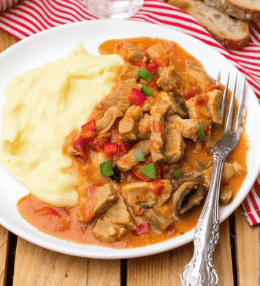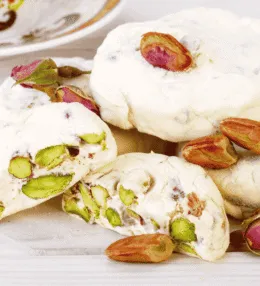
- View
Table of Contents
TogglePicture this: you’re standing beside a crackling fire as the sun sets over the Pacific Northwest, and the rich aroma of salmon slowly cooking on cedar wood fills the evening air. This isn’t just dinner; it’s a culinary tradition that has nourished Indigenous communities.
Cedar planked salmon represents far more than a cooking method. It’s a beautiful marriage between the natural resources of the coastal forests and the abundant waters of the Pacific, creating a dish that tells the story of Indigenous innovation and respect for nature.
The technique transforms ordinary grilled fish into something extraordinary. When salmon meets cedar, magic happens. The wood doesn’t just serve as a cooking surface; it becomes an integral flavour component that infuses the fish with subtle, aromatic notes.
Want to dive deeper into Canadian Cuisine? Don’t miss our post on Traditional Canadian Foods to Try
What Is Cedar Planked Salmon?
Cedar planked salmon is a traditional Indigenous cooking method where fresh salmon fillets are placed directly onto soaked cedar planks and cooked over an open fire or on a modern grill. The cedar acts as both a cooking vessel and a flavour enhancer.
Unlike typical grilling where fish sits on metal grates, the cedar plank method creates a barrier between the fish and direct heat. This results in incredibly moist, flaky salmon that retains its natural oils and develops a delicate smoky character.
The process requires patience and respect for the ingredients. Cedar planks must be soaked in water for several hours before use, preventing them from catching fire while allowing them to slowly release steam and aromatic compounds during cooking.
Ingredients and Taste
The beauty of cedar planked salmon lies in its simplicity. Traditional preparations focus on high-quality ingredients that complement rather than mask the fish’s natural flavours. Fresh Pacific salmon serves as the foundation, whether it’s chinook, coho, or sockeye varieties.
Seasonings remain minimal and purposeful. Sea salt, often harvested locally, enhances the salmon’s inherent richness. Wild herbs like juniper berries, gathered from the coastal forests, add subtle piney notes that harmonise beautifully with the cedar.
The taste experience is unlike anything you’ll encounter with conventionally prepared salmon. The cedar imparts gentle smokiness without overwhelming the fish’s delicate flavour. Each bite delivers moist, flaky texture with hints of vanilla and spice from the wood.
A Taste of History
The origins of cedar planked salmon stretch back millennia along Canada’s Pacific coast, where Indigenous nations including the Squamish, Tsilhqot’in, and Haida developed this remarkable cooking technique. These coastal peoples understood the symbiotic relationship between towering cedar forests.
Cedar held sacred significance in Indigenous cultures, valued not only for its practical applications in building and crafts but also for its spiritual importance. The tree’s aromatic properties were believed to purify and protect, making it a natural choice for preparing salmon.
The technique served practical purposes beyond flavour. Cedar’s natural antimicrobial properties helped preserve the fish, whilst the plank method allowed for efficient cooking of large quantities during salmon runs when communities would gather to harvest fish.
Today, cedar planked salmon has found its way into contemporary Canadian cuisine, appearing in restaurants from Vancouver to Toronto. However, its preparation carries the responsibility of honouring the Indigenous traditions from which it originated.
How to Make Cedar Planked Salmon (Grilled Indigenous Fish)
Cedar planked salmon is a celebrated preparation among Indigenous peoples of the Pacific Northwest, where fresh fish meets the gentle smoke of soaked cedar. Expect moist, aromatic flesh with a subtle wood-kissed flavour and crisp edges. The process is simple but demands patience with soaking and steady grilling for best results. See the recipe card at the bottom for printable directions
Ingredients
For the salmon
- 4 salmon fillets (about 180–200 g each, skin on)
- 2 untreated cedar planks (about 30 cm long, food safe, soaked in water for at least 2 hours)
- 2 tbsp olive oil
- 1 tsp coarse sea salt
- 1 tsp cracked black pepper
- 2 tbsp pure maple syrup
- 2 cloves garlic, finely minced
- Juice of 1 lemon
- 1 small bunch fresh dill
For serving
- Lemon wedges
- Extra maple syrup (optional drizzle)
- Wild rice or roasted root vegetables
Cooking Instructions
Step 1: Soak the cedar planks
To begin, fully submerge the cedar planks in cold water for at least 2 hours. Place a weight on top to prevent floating. This prevents burning and encourages gentle steaming during cooking. Move to preparing the marinade.
Step 2: Mix the marinade
In a bowl, whisk together olive oil, maple syrup, lemon juice, minced garlic, salt, and pepper. Stir until smooth. This creates a glaze that balances sweetness, tang, and savoury depth. Transition to coating the salmon.
Step 3: Marinate the salmon
Place the salmon fillets in a shallow dish. Brush generously with the marinade, reserving a little for basting. Let the fish rest in the fridge for 30 minutes to absorb flavour. Continue to heating the grill.
Step 4: Prepare the grill
Preheat a charcoal or gas grill to medium heat (around 180–200°C). Ensure one side is slightly cooler for indirect cooking. When hot, place soaked cedar planks directly on the grates to warm for 2–3 minutes. Proceed to placing the salmon.
Step 5: Place salmon on planks
Lay salmon fillets skin-side down on the heated cedar planks. Top each with sprigs of fresh dill. The wood will sizzle lightly, releasing its aroma. Transition to cooking slowly.
Step 6: Grill with the lid closed
Close the lid and grill for 15–20 minutes, depending on thickness, until the salmon flakes easily with a fork but remains moist inside. Avoid flipping. Move to basting midway.
Step 7: Baste with marinade
Halfway through grilling, open the lid briefly and brush the salmon with the reserved marinade for extra flavour and sheen. Close lid again and continue cooking. Transition to final garnish.
Step 8: Finish with lemon
Once cooked, carefully transfer cedar planks from the grill to a serving tray. Squeeze fresh lemon juice over the fillets and allow them to rest briefly. Move to plating.
Final step: Serve on cedar
Serve the salmon directly on the cedar planks for presentation and aroma. Accompany with lemon wedges, wild rice, or roasted root vegetables. Optional drizzle of warm maple syrup adds depth.
Variations and substitutions
- If cedar planks are unavailable, use alder or oak planks for a similar effect.
- Maple syrup can be replaced with honey if needed, though the flavour will be lighter.
- Fresh dill may be substituted with parsley or tarragon for herbal notes.
- For oven cooking, place planks on a baking sheet and cook at 200°C.
Cooking Tips for Perfect Cedar Planked Salmon
- Always soak cedar planks thoroughly to avoid flare-ups.
- Keep a spray bottle of water nearby to control flames if the wood chars too quickly.
- Use wild-caught salmon for authentic taste and firmer texture.
- Let the salmon rest for a few minutes before serving to keep juices inside.
- Do not overcook; salmon should be moist and flake gently when tested with a fork.

Cedar Planked Salmon (Grilled Fish)
Ingredients
For the salmon
- 4 salmon fillets about 180–200 g each, skin on
- 2 untreated cedar planks about 30 cm long, food safe, soaked in water for at least 2 hours
- 2 tbsp olive oil
- 1 tsp coarse sea salt
- 1 tsp cracked black pepper
- 2 tbsp pure maple syrup
- 2 cloves garlic finely minced
- Juice of 1 lemon
- 1 small bunch fresh dill
For serving
- Lemon wedges
- Extra maple syrup optional drizzle
- Wild rice or roasted root vegetables
Instructions
- To begin, fully submerge the cedar planks in cold water for at least 2 hours. Place a weight on top to prevent floating. This prevents burning and encourages gentle steaming during cooking. Move to preparing the marinade.
- In a bowl, whisk together olive oil, maple syrup, lemon juice, minced garlic, salt, and pepper. Stir until smooth. This creates a glaze that balances sweetness, tang, and savoury depth. Transition to coating the salmon.
- Place the salmon fillets in a shallow dish. Brush generously with the marinade, reserving a little for basting. Let the fish rest in the fridge for 30 minutes to absorb flavour. Continue to heating the grill.
- Preheat a charcoal or gas grill to medium heat (around 180–200°C). Ensure one side is slightly cooler for indirect cooking. When hot, place soaked cedar planks directly on the grates to warm for 2–3 minutes. Proceed to placing the salmon.
- Lay salmon fillets skin-side down on the heated cedar planks. Top each with sprigs of fresh dill. The wood will sizzle lightly, releasing its aroma. Transition to cooking slowly.
- Close the lid and grill for 15–20 minutes, depending on thickness, until the salmon flakes easily with a fork but remains moist inside. Avoid flipping. Move to basting midway.
- Halfway through grilling, open the lid briefly and brush the salmon with the reserved marinade for extra flavour and sheen. Close lid again and continue cooking. Transition to final garnish.
- Once cooked, carefully transfer cedar planks from the grill to a serving tray. Squeeze fresh lemon juice over the fillets and allow them to rest briefly. Move to plating.
- Serve the salmon directly on the cedar planks for presentation and aroma. Accompany with lemon wedges, wild rice, or roasted root vegetables. Optional drizzle of warm maple syrup adds depth.
Nutrition
You May Also Like







Leave a Review